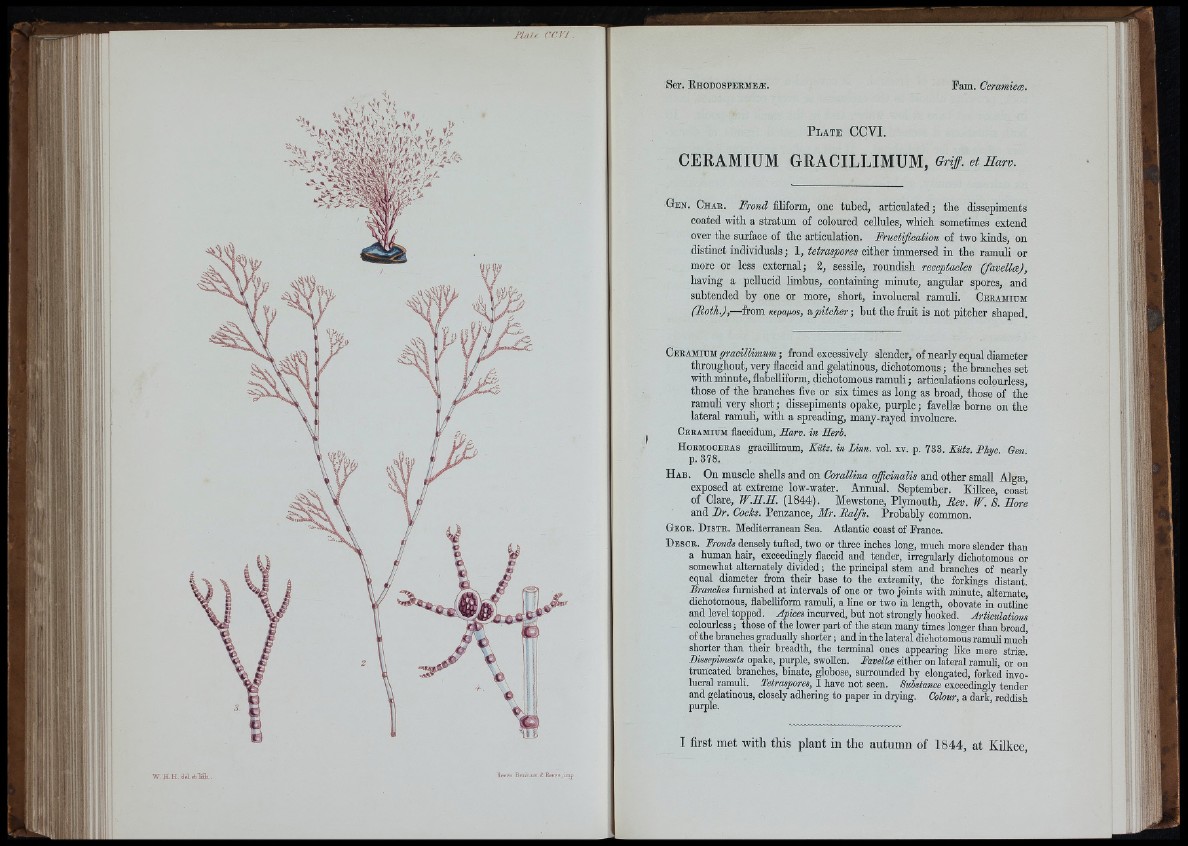
Plu!, r r i ' i .
I
4 7Í
L à
'w.aH.dAitm. Rfpvo Beiih.i2TL&E#flvo.Im
P l a t e CCVI.
CERAMIUM GRACILLIMUM, Griff. et Harv.
G e n . Ch a r . Frond filiform, one tubed, articulated; the dissepiments
coated with a stratum of coloured cellules, which sometimes extend
over the surface of the articulation. Fructification of two kinds, on
distinct individuals ; 1, tetraspores either immersed in the ramuli or
more or less external; 2, sessile, roundish reeeptacles (favelloe),
having a pellucid limbus, containing minute, angular spores, and
subtended by one or more, short, involucral ramuli. Ceramium
(R o th .),—from Kepagos, a p itch e r ; but the fruit is not pitcher shaped.
Ceramium gracilUmvm ; frond excessively slender, of nearly equal diameter
throughout, very fiaccid and gelatinous, dichotomous; the branches set
with minute, flabelliform, dichotomous ramuli ; articulations colourless,
those of the branches five or six times as long as broad, those of the
ramuli very short ; dissepiments opake, purple ; faveUæ borne on the
lateral ramuli, with a spreading, many-rayed involucre.
Ce r a m iu m flaccidum,\Hoer®. in Herh.
H orm o o era s gracillimum, Kütz. in Linn. vol. xv. p. 733. Kütz Phyc Gen
p. 378.
H ab. On muscle shells and on Corallina offidnaUs and other smaU Algæ,
exposed at extreme low-water. Annual. September. Kilkee, coast
of Clare, W .H .H . (1844). Mewstone, Plymouth, Rev. W. S. Hore
and Hr. Cocks. Penzance, M r. R a lfs . Probably common.
G e o r . D i s t b . Mediterranean Sea. Atlantic coast of France.
D e s c r . Fronds densely tufted, two or three inches long, much more slender than
a human hair, exceedingly flaccid and tender, irregularly dichotomous or
somewhat alternately divided ; the principal stem and branches of nearly
equal diameter from their base to the extremity, the forkings distant.
Branches furnished at intervals of one or two joints with minute, alternate,
dichotomous, flabeUiform ramuli, a line or two in length, obovate in outline’
and level topped. Apices incurved, but not strongly hooked. Articulations
colourless ; those of the lower part of the stem many times longer than broad,
of the branches gradually shorter ; and in the lateral dichotomous ramuli much
shorter than their breadth, the terminal ones appearing Hke mere striæ.
Dissepiments opake, purple, swollen. Favellæ either on lateral ramuli, or on
truncated branches, binate, globose, surrounded by elongated, forked invo-
lucral ramuli. Tetraspores, I have not seen. Substance exceedingly tender
and gelatinous, closely adhering to paper in drying. Colour, a dark,” reddish
purple.
I first met with this plant in the autumn of 1844, at Kilkee,
1I'l'
f'!':
■